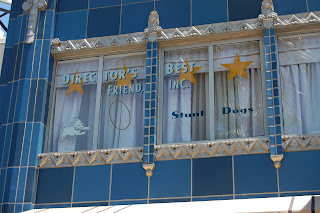The tradition of Main Street windows goes all the way back to Disneyland in the 1950s. Walt and his designers crafted what appeared to be ads for second-story businesses above the Main St. shops, all as a way to pay tribute to those individuals who helped build the park and make it a success. That tradition continues today in all the Disney Parks around the world.
In Paris, you can find nods to everyone from Disney family members to the leaders and Imagineers who played roles in the park's 1992 opening. The windows in the offices of the Main St. Gazette (above) feature the names of Disney Legend Marty Sklar (who began his career creating the Disneyland News in 1955 and went on to lead Walt Disney Imagineering), Tony Baxter (the chief Imagineer on the Disneyland Paris project), as well as the names of individuals who directed the original marketing and publicity campaigns for the park.
There's also a window nearby for the Main St. Marching Band, honoring "Conductors" Michael Eisner and Frank Wells, the top executives at Disney who brought the resort to France. The window says they've been "Leading the Parade Since 1884," a reference to the year (1984) in which Michael and Frank joined the company.
Michael Eisner and Frank Wells had a very successful working relationship, one similar in many ways to the founders of the company. They're honored many places, but specifically on the window for Two Brothers, Inc. Roy O. Disney and Walt E. Disney are listed as Founders and Partners, Dreamers & Doers.
Some windows pay tribute to hobbies, pastimes and other elements from Walt Disney's life, like this shingle for the business office of the Carolwood Pacific Railroad. Carolwood Pacific was the miniature railroad Walt had built in his backyard.
It's not just Walt and his hobbies, though. Roy E. Disney, Walt's nephew, was a key executive in the company at the time of the Disneyland Paris opening. He was also an avid sailor, so it's appropriate that he's listed as Captain of Pyewacket Cruise Lines. Pyewacket is the name Roy used for a series of sailing boats he owned and raced over the years (the Disney-produced film Morning Light tells the story of one such race, the Transpac).
Main Street at Disneyland Paris is unique in that some of the windows, ads and businesses are also used to refer to characters or stories from Disney films and TV shows. Harrington's Fine China & Porcelains shop is named for Polly Harrington, played by Jane Wyman in the 1960 Disney film, Pollyanna. The movie is set in the same time period as Main St., U.S.A. In the story, Aunt Polly is the wealthiest woman in town, so it's fitting that the interior of the Harrington's shop is one of the most ornate on the street.
A window above the Market House Delicatessen promotes Digby's Messenger Service, a reference to Digby Popham, the character played by Michael J. Pollard in Summer Magic (1963). In the movie, Digby dreamed of leaving Beulah, Maine, and moving to the big city. Looks like he may have gotten his wish.
Right next door is Evans and Markham Advertising. This refers to the 1950s "Mickey Mouse Club" serials, "The Adventures of Spin and Marty." The main characters' names were Spin Evans and Marty Markham. (On a personal note: My son Evan got his name from Spin Evans, too. His twin brother, Riley, was named for Dexter Riley, Kurt Russell's character in The Computer Wore Tennis Shoes. Yes, my wife and I are BIG Disney fans!)
One last window I'd like to share with you is that of M. Jones Electronics. I particularly love it, because it not only refers to a classic Disney film, but also carries forward the story of Main Street, U.S.A., and its theme of progress. M. Jones, of course, comes from The Misadventures of Merlin Jones, a 1964 comedy which starred Tommy Kirk as a "scrambled egghead" of an inventor (A sequel, The Monkey's Uncle, came out in 1965). Here, he's offering Edison Talking Machines, bringing the latest in early-20th century technology to the citizens of Main St.
























